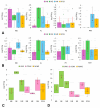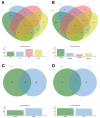Endophytic Diversity in Sicilian Olive Trees: Identifying Optimal Conditions for a Functional Microbial Collection
- PMID: 40732010
- PMCID: PMC12298726
- DOI: 10.3390/microorganisms13071502
Endophytic Diversity in Sicilian Olive Trees: Identifying Optimal Conditions for a Functional Microbial Collection
Abstract
This study aims to identify the optimal conditions-host, plant material, seasonality, and agricultural practices-for isolating and developing a collection of culturable endophytic microorganisms to support sustainable Olea europaea L. cultivation. Samples were collected from three Sicilian olive cultivars ('Nocellara del Belice', 'Nocellara Etnea', and 'Nocellara Messinese') and six wild olive accessions across different phenological phases and under organic and conventional agronomic management. Endophytes were isolated from leaves and twigs using a culture-dependent approach, and their taxonomic diversity and plant-growth-promoting (PGP) traits were analyzed. A total of 133 endophytic isolates were identified, spanning bacterial (Proteobacteria, Firmicutes, and Actinobacteria) and fungal (Ascomycota and Basidiomycota) phyla. Wild olive trees contributed more than cultivated varieties to enriching the diversity and composition of culturable endophyte collection as well as twigs instead of leaves. Winter sampling allowed to implement the taxonomic genera of olive endophyte collection. Both farming systems favored an increase in the composition of microbial collection, though organic farming systems supported greater microbial richness. Functional analysis highlighted key PGP traits in a selection of bacterial isolates, including indole-3-acetic acid and siderophore production, nitrogen fixation, and antifungal activity. Bacillus spp. dominated enzymatic activities, such as amylase, protease, and lipase production, as well as antifungal activity against the olive fungal pathogen Neofusicoccum vitifusiforme. This research highlights the significant diversity and functional potential of Mediterranean olive endophytes. Our findings emphasize the role of native microbial communities as bio-inoculants, promoting plant growth, nutrient uptake, and disease resistance. These insights lay the groundwork for developing targeted olive-microbial consortia for biocontrol and stress tolerance applications.
Keywords: Olea europaea L. subsp. europaea var. europaea; Olea europaea L. subsp. europaea var. sylvestris; antifungal activity; cv. ‘Nocellara Etnea’; cv. ‘Nocellara Messinese’; cv. ‘Nocellara del Belice’; olive microbiota; plant growth-promoting microorganisms.
Conflict of interest statement
The authors declare no conflicts of interest.
Figures





Similar articles
-
Characterization of differences in seed endophytic microbiome in conventional and organic rice by amplicon-based sequencing and culturing methods.Microbiol Spectr. 2024 Oct 3;12(10):e0366223. doi: 10.1128/spectrum.03662-23. Epub 2024 Aug 13. Microbiol Spectr. 2024. PMID: 39136439 Free PMC article.
-
First Report of Root-Knot Nematode Meloidogyne incognita on Olea europaea in the Republic of Korea.Plant Dis. 2025 Jun 27. doi: 10.1094/PDIS-05-25-1024-PDN. Online ahead of print. Plant Dis. 2025. PMID: 40579837
-
Roots of domestication: unveiling the dynamics of domestication through trait-based analysis of olive trees in northern Morocco.Philos Trans R Soc Lond B Biol Sci. 2025 May;380(1926):20240201. doi: 10.1098/rstb.2024.0201. Epub 2025 May 15. Philos Trans R Soc Lond B Biol Sci. 2025. PMID: 40370023
-
Innovations towards sustainable olive crop management: a new dawn by precision agriculture including endo-therapy.Front Plant Sci. 2023 Jun 6;14:1180632. doi: 10.3389/fpls.2023.1180632. eCollection 2023. Front Plant Sci. 2023. PMID: 37351220 Free PMC article. Review.
-
An Insight into Microbial Inoculants for Bioconversion of Waste Biomass into Sustainable "Bio-Organic" Fertilizers: A Bibliometric Analysis and Systematic Literature Review.Int J Mol Sci. 2022 Oct 27;23(21):13049. doi: 10.3390/ijms232113049. Int J Mol Sci. 2022. PMID: 36361844 Free PMC article.
References
Grants and funding
LinkOut - more resources
Full Text Sources
Miscellaneous

